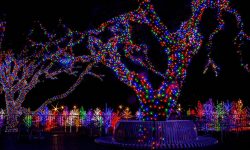Five Important Decisions to Make When Buying LED Christmas Lights
This Christmas light buying guide will guide you through some of the major choices you’ll need to make when shopping for your lights this season. Whether you are shopping for your home or are in need of commercial Christmas lights, you’ll find a few helpful tips for picking out the lights that best suit your needs. It won’t take long until you’ll be able to create a holiday light display that impresses your friends, family, or customers.
Benefits of LED Lighting
It seems like only yesterday that LED Christmas lights were the new kids on the block. Up until about ten years ago, traditional incandescent lights were the most popular type of Christmas lights, as they had been for many decades.
But in just a few short years, that changed. LED lights became more and more popular. And now, because of the many unique benefits they offer, LED lights are the most popular type of Christmas light.
If you're going to be in the market for some Christmas lights this season, you'll need to choose between incandescents and LEDs. And if you're like most consumers these days, you'll choose LEDs. But once you've made that decision, you'll have several more to make. In this LED Christmas lights buying guide, we’ll go over a few of these decisions, to make sure you know how to pick Christmas lights that will work for your indoor and outdoor spaces.
Decision #1: Light Bulb Size
Christmas lights for personal use may vary greatly from the types of lights you’ll need to assemble commercial Christmas light displays. To begin deciding which lights are best for your situation, you’ll need to consider the shape and size of the LED’s lightbulb.
What Size are Christmas Light Bulbs?
Christmas LED lights are available in several different sizes and styles. Which will suit your needs the best? It'll probably be a combo of sizes and styles. Here's what you'll be able to choose from, along with a brief description of each:
- 5 mm Wide Angle Conical: This is a very popular bulb. In fact, it's the #1 LED light used by pro-Christmas lighting
- installers. The concave lens serves to maximize illumination far beyond that of traditional incandescent mini-lights.
- M5 LED Lights: The M5 is a combo of classic lens design and modern LED technology. M5s are not as intense as Wide Angle Conicals, but they offer a more even lighting that's equally visible from just about any angle. M5s are one of the better choices for interior light displays because their intensity is not bright enough to be distracting or annoying in an interior setting.
- C6 LED Lights: Also known as diamond-cut LED lights. A historically underused bulb that's rapidly growing in popularity because of the versatility it offers for both indoor and outdoor lighting. C6s are very popular for use in decorating Christmas trees.
- C7 LED Christmas Lights: C7s have long been one of the most popular bulb sizes. Their mid-range size makes them perfect for a wide variety of lighting designs.
- C9 LED Christmas Lights: This is the largest bulb size available in the traditional teardrop style. C9s are particularly popular in LEDs because they're so energy-efficient in spite of their large size.
Decision #2: Half Wave or Full Wave Lights
In case you didn't know, LED lights come in either half-wave or full-wave versions. What's the difference? It has to do with the speed of the flicker.
All LED lights cycle on and off very rapidly. That's partly why they're so energy efficient. But they don't all cycle on/off at the same rates. Half-wave lights cycle at about 60 times per second. Full-wave lights cycle twice as fast at 120 times per second.
Why should you care? The slower cycling of the half-wave lights creates a flicker effect that is noticeable to some people. Not everyone notices it. But for those who do, the effect can be annoying and distracting. Some people even experience headaches as a result.
The flicker problem is non-existent with full-wave lights. They cycle on/off far too fast for the human eye to detect. Half-wave lights are generally less expensive than full-wave lights. And that's why many people end up with half waves - whether they really want them or not. In fact, many people buy cheaper sets without realizing what they're getting.
To avoid encountering any of the potential problems of half-wave LED lights, buy full wave lights from pro-grade Christmas light companies like us. Professional quality Christmas lights offer some other advantages as well.
Decision #3: Define Your White
White Christmas lights come in a variety of different options, ranging from warm to cool white. It's important to stay consistent once you choose from the color varieties of white Christmas lights.

Cool white lights are white with a little bit of blue mixed in, giving them a 'cooler' look. Warm white LED Christmas lights mix a touch of yellow in with the white for a 'warmer' appearance. Pure white is the complete absence of any color from the bulb. For more information on the different shades of white Christmas lights, check out the LED Christmas lights color temperature scale.
Before you begin your Christmas light shopping, decide which type of white light will best fit your needs and preferences.
Decision #4: Stringers or Empty Socket
If you'll be using C7 or C9 bulbs on your display, you'll have another decision to make. That's because you can buy lines for these two sizes as either stringer sets or empty socket lines.
Here's the primary difference: Stringer sets come in preset lengths. Once you buy a stringer set, you cannot alter the length of the line. The alternative is to buy an empty socket light line and make your own custom-length lines.
The stringer set is the easiest choice. But the empty socket lines are the best choice for a quality, professional-looking installation.
But before you decide which will be best for you, you might want to spend some time learning more about the differences between stringer sets and empty socket lines.
Decision #5: Solid Color or RGB LED Lights?
Many Christmas decorators have a light color or a color scheme in mind when designing a Christmas display. Along with warm, cool and pure white, the most popular LED light colors are red, green and blue. But what if you aren't sure what color you want? Or what if you need the ability to adjust the light colors in your display?
That's where RGB Christmas lights come in. RGB lights are created with three LED diodes (for red, green and blue) and together, the diodes can produce a full rainbow spectrum of color options.

In the past, the downside to RGB LED lights is that you usually need advanced skills to program the desired colors and effects. But luckily for you, brands like Twinkly have created smart RGB lights that can be mapped and controlled with a phone app. RGB LED lighting is constantly evolving with the latest, greatest technology. They are definitely worth considering if you desire flexibility with your LED light colors.
Can RGB LEDs Make White Light?
The color combinations available with RGB lights are extensive. The right mix of red, blue, and green can simulate a variety of white light temperatures, ranging from cool white LED lights to their warm white counterparts. As mentioned above, the flexibility of RGB lights is nearly limitless.
What Are the Best Christmas Lights to Buy?
There certainly are lots of decisions to be made when shopping for Christmas lights. We hope this guide will give you a good foundation to choose what's right for you and your Christmas light display. You should ultimately aim to purchase the Christmas lights that best suit your needs and decorative uses.
After all, what's worse than having lots of choices? Having too few choices. With Christmas Designers, you won't have that problem when you're shopping for Christmas lights this holiday season.








